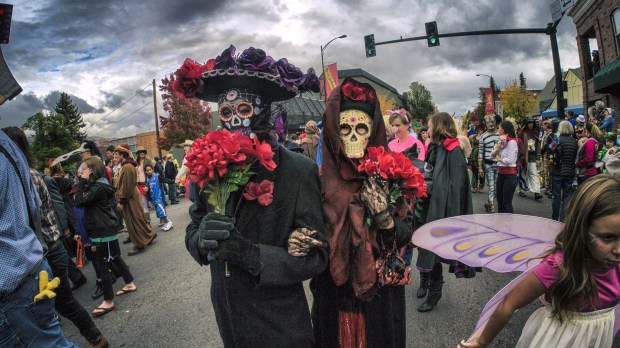Being born and raised in Mexico comes with certain advantages, including getting to “skip” school a whole lot for being Catholic. November 1 and 2 are holidays, arranged in a long weekend that my family and I would spend away from our home city in a quaint village called Valle de Bravo. Our little bungalow is located very near one of the town’s main cemeteries.
Every year at this time I’d hear the chants and prayers of the many people gathered at the graveyard visiting their loved ones. All Saints Day was a magical night filled with candles, flowers, pictures of those who had gone on to eternity and the luscious smells of fresh-baked bread, hot cocoa and tequila. It also meant one of my favorite liturgies of the year, with the description of heaven and the reminder that we were worshipping alongside the saints, drawn up in their contemplation of God. As a child, the Mass would give me shivers and make me want to “excel” at my faith, so that one day I would be kneeling at his throne too.
Unlike Halloween the celebration of Todos los Santos and Dia de los Muertos is a festive, colorful occasion in Mexico, surrounded with unique folkloric elements that only appear at this time of year. There’s “pan de muerto” (bread of the dead), which is a puffed sweet loaf representing a bunch of bones in a pile, and sugar skulls (and nowadays chocolate skulls), generally given to friends and family as a gift. The most traditional celebrations take place in the cities of Pátzcuaro in Michoacán, Cuetzálan in Puebla and Oaxaca.
A main element of the celebration is the trip to the cemetery to pray and decorate the tombs, mainly using the orange (and sometimes purple) flower of cempazuchitl.
The feast-day liturgies are for many people a very important part of the celebration. For us in Valle de Bravo, after the latest of a half dozen or more Todos los Santos masses ended around 8:00 pm or maybe even nine, the faithful would start a procession from the church to the cemeteries. With my siblings, I’d attend the liturgy and walk back home among the crowd afterwards, listening to the chants and praying the Rosary, feeling every word of prayer. It was a magical moment, almost like a Via Crucis.
Meanwhile at home, altars are built in honor of deceased relatives. Pictures of these loved ones are displayed, along with their favorite foods, drinks and pastimes, as if the dead could and would come back during the night to remember these pleasures of their “mundane life.” If the altar is dedicated to children, their favorite toys are displayed and set for playtime during this “night visit.”
Many will say building this altar is their favorite tradition of the year, even more than Christmas. And their motives and methods in building the altars are as unique and varied as the friends and relatives they honor.
Gina, one of my closest friends, sets up an altar in honor of her great-aunt, who left her an apartment in her will. The altar is an act of gratitude for receiving her home.
Jacquie builds her altar in Montpellier, a bit because she is far away from home and wants her daughter to get familiar with this Mexican tradition and culture, and a bit because she remembers her grandma and those in her family who now rest in peace.
Patty helps build her family altar because her grandmother built it and her mom builds it now, under the stairs in her house. They gather and set it up as a family tradition, always a good “excuse” to spend time together and teach the kids to respect the memories of their departed loved ones.
As with any tradition blended from folklore and faith, and now an element of popular piety, there is a range of beliefs associated with the altar. For some it’s merely a decoration of the season; for others it’s a macabre, fearsome ritual inviting the dead to come back to life.
Two of my friends, sisters, told me how their own experience of the Day of the Dead is truly a spiritual, Catholic tradition for All Hallows Day.
They lost their father some years ago, and their children never met Grandpa. Both Daniela and Araceli set up an altar, each one in her home, in honor of their father. Daniela does it in her own way, with flowers and a picture of her dad, telling stories to her kids about him. She uses the altar and the feast to emphasize the importance of praying for the souls in purgatory and asking the saints’ intercession.
Araceli is more traditional and has a deeper sense of worship about her. She, her husband and four kids attend Mass early in the morning and build the altar on All Saints Day, and while they set it up, they pray and remember their departed by watching videos or going through family photo albums, thanking God for the happy moments they shared and asking for their intercession in heaven. They pray about the feast of All Saints, remembering that these souls are already enjoying the Glory of God and his love forever in heaven. Thus it is a happy, blessed day, and a reminder of our purpose in life. She teaches her children we all must become saints.
The Day of the Dead is a beautiful way to celebrate All Saints and All Souls Day, both with the liturgies, visit to the cemetery and the indulgence to be gained, and with the home altars, to keep the memories of our departed alive, and to remind us all that, as the Catechism says, “Because of Christ, Christian death has a positive meaning.”
Guille Guzmanis a health coach, home chef and translator who lives in Mexico City, where she stays busy with baking and crafting, but above all with raising her spunky 6-year-old daughter.

